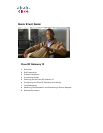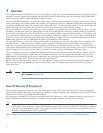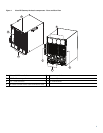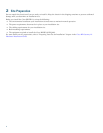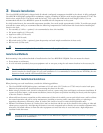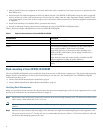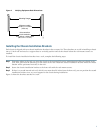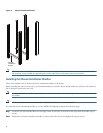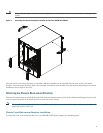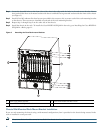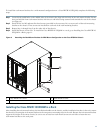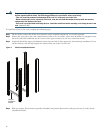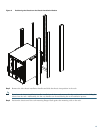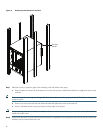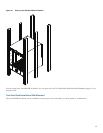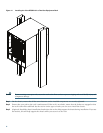
5
3 Chassis Installation
The Cisco RFGW-10 UEQAM is shipped with all ordered (configured) components installed in the chassis. A fully configured
Cisco RFGW-10 UEQAM (configured for redundancy support, including 10 RF line cards) weighs approximately 275 lbs. The
chassis alone weighs 91 lbs. The chassis with the fan tray, TCC cards, and all RF switch cards weighs 138 lbs. It is not
recommended that the Cisco RFGW-10 system be installed with all components in the system.
In a fully loaded chassis, the removable components (modules, line cards) weigh approximately 184 lbs. To enable two people
to install the system safely, we recommend that the following components be removed from the chassis before installing the
chassis in the rack:
• Fan assembly (13.0 lbs— optional, it is recommended to leave this installed)
• DC power supplies (15.5 lbs each)
• Supervisor cards (5.5 lbs each)
• TCC cards (2.0 lbs each)
• RF switch cards (2.5 lbs— optional, given the quantity and total weight contribution of these cards)
• RF line cards (9.5 lbs each)
Caution You must use a hydraulic lift or forklift to move a fully populated chassis.
Installation Methods
Rack-mounting is the preferred method of installation for the Cisco RFGW-10 UEQAM. You can mount the chassis:
• Front mount or mid mount
• In a 19 inch wide (standard), four-post equipment rack or two-post, using the rack-mount brackets in the accessory kit
Note The Cisco RFGW-10 UEQAM usually ships fully loaded. It is recommended that you remove the components from the
chassis to make the chassis lighter for your rack installation. It is recommended to remove the two DC PEMs, the two
Supervisor Cards, and the 10 Universal RF Line Cards.
General Rack Installation Guidelines
When planning your rack installation, consider the following guidelines:
• The Cisco RFGW-10 UEQAM requires a minimum of 13 rack units (22.75 inches or 577.85 mm) of vertical rack space.
Measure the proposed rack location before mounting the chassis in the rack.
• Before using a particular rack, check for obstructions (such as a power strip) that could impair rack-mount installation. If
a power strip does impair a rack-mount installation, remove the power strip before installing the chassis, and then replace
it after the chassis is installed.
• Allow sufficient clearance around the rack for maintenance. If the rack is mobile, you can push it back near a wall or cabinet
for normal operation and pull it out for maintenance (installing or moving cards, connecting cables, or replacing or
upgrading components). Otherwise, allow 36 inches (914.4 mm) of access to remove field replaceable units.
• Maintain a minimum clearance of 4 inches (101.6 mm) on the front and the rear of the chassis for the cooling air inlet and
exhaust ports, respectively. Avoid placing the chassis in an overly congested rack or directly next to another equipment rack;
otherwise, the heated exhaust air from the other equipment can enter the inlet air vents and cause a high temperature
condition inside the router.
Caution To prevent chassis overheating, never install a Cisco RFGW-10 UEQAM in an enclosed room that is not properly
ventilated or air conditioned.



